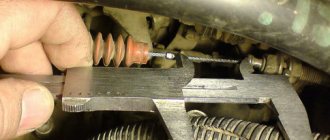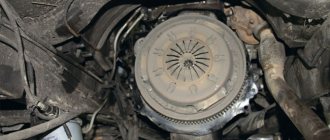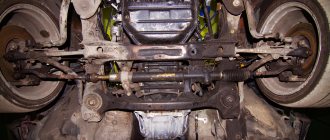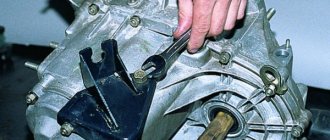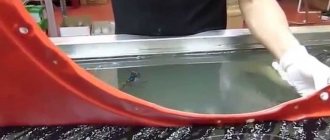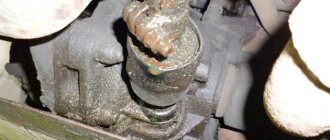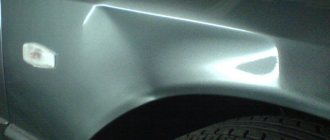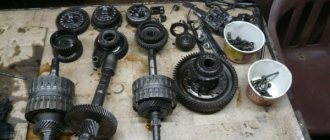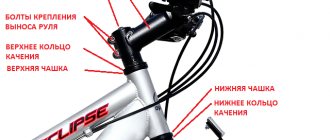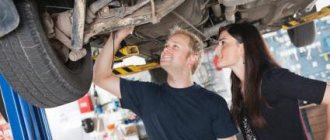A planetary gear with a stationary carrier is essentially a two-stage gear train with stationary wheel axles. Planetary gear (sun gear stopped)
Planetary gear (ring gear stopped)
Diagram of an epicyclically moving planet
Planetary gear
(
hereinafter referred to as PP
) is a mechanical transmission of rotational motion, due to its design, capable of changing, folding and unfolding the supplied angular velocities and/or torque within one geometric axis of rotation. Usually it is an element of the transmission of various technological and transport machines.
Structurally, a PP is always a set of interlocking gear wheels (at least 4), some of which (at least 2) have a common geometric fixed axis of rotation, and the other part (also, at least 2) have movable axes of rotation, concentrically rotating on the so-called “drove” around the stationary one. Gear wheels on a fixed axle are always connected to each other not directly, but through gear wheels on moving axles, and due to the fact that the latter are capable of not only rotating relative to the first, but also running them, thereby transmitting translational motion to the carrier, all PP links , to which power can be supplied/removed, are able to rotate differentially, with the only condition that the angular velocity of any such link is not absolutely chaotic, but is determined by the angular velocities of all other links. In this regard, the PP is similar to a planetary system, in which the speed of each planet is determined by the speeds of all other planets in the system. The differential principle of rotation of the entire system, as well as the fact that in its canonical form the set of gear wheels that make up the PP are assembled in some semblance of the sun and epicyclically moving planets in orbit, gives this mechanical transmission such inherent only international definitions as planetary
,
differential
(from the Latin differentia - difference, difference) or
epicyclic
, each of which in this case is synonymous.
From the point of view of theoretical mechanics, a planetary gear is a mechanical system with two or more degrees of freedom. This feature, which is a direct consequence of the design, is an important difference between the PP and any other rotational motion transmissions, which always have only one degree of freedom. And this feature gives the PP itself the important quality that, in terms of influencing the angular speeds of rotation, the PP can not only reduce these speeds, but also fold and unfold them, which, in turn, makes it the main mechanical actuator unit not only for various planetary gearboxes , but such devices as differentials and summing PPs.
Content
- 1 Planetary gear and planetary gear 1.1 Composition of the planetary gear
- 1.2 Simple and complex PM, planetary gear
- 1.3 Planar and spatial PMs
- 1.4 2 degrees of freedom PM
- 1.5 Gear ratio 1.5.1 Willis formula
- 3.1 Planetary rotation mechanism
Planetary gear control elements
The presence of two or more degrees of freedom in any PM and their assemblies can be used in some types of PM as the main functionality (here we mean planetary differentials, flow splitters and summing PM). However, for the PP to operate in gearbox mode with one leading link and one driven by all other free main links, it is necessary to set a certain angular velocity (including, possibly, zero). Only in this case will the extra degrees of freedom be removed, all the free main links will become supporting links, and all the power supplied to the single driving link will be removed from the single driven link in full (adjusted for the efficiency of the PP). The function of setting the required angular velocities to the free links is performed by the so-called PM control elements. There are two such elements: clutches and brakes.
- Friction clutches connect two free PM links to each other, or connect a free link to an external power supply. In both cases, when fully locked, the clutches provide the pair of connected elements with a certain identical non-zero angular velocity. Structurally, they are usually made in the form of multi-disc friction clutches, although in some cases simpler clutches are also possible.
- The brakes connect the free links of the PM to the PP body. When fully locked, the brakes provide the braked free link with zero angular velocity. Structurally, they can be similar to friction clutches - in the form of multi-disc friction clutches; but simpler designs are also widespread - tape, block, single-disc.
According to the principle of their operation, clutches and brakes are ideal synchronizers of the angular velocities of the connected elements. They also perform safety functions and can slip under sudden shock loads, transferring dynamic loads into the work of friction forces. And they can also perform the function of the main clutch (main clutch), so often in mechanical transmissions of cars with a control gearbox the main clutch is not used at all. Despite the fact that brakes, unlike clutches, allow more options for actual design, the design of both can be exactly the same, or at least unified, despite the significant functional difference between clutches and brakes. In addition to clutches and brakes, automatically activated freewheel mechanisms (another name for them are overrunning clutches or autologs) can be used in the operation of the PP. In Russian-language kinematic diagrams of planetary gearboxes, clutches, brakes and freewheels are usually designated by the letters F, T and M.
Planetary gear and planetary mechanism [edit | edit code ]
In Russian-language engineering terminology, the terms planetary gear (hereinafter - PP) and planetary mechanism (hereinafter - PM) are often assumed as synonyms. The differences are that the term PP is usually used in the context of a fundamental understanding of the structure of a particular transmission of rotational motion, especially if the device of such a transmission is not obvious (hidden by the housing/crankcase) or such a transmission has certain unique properties inherent only in a planetary one, and this is what needs to be done emphasize attention. And the term PM is used to designate a specific gear-lever mechanism, and there are criteria that make it possible to clearly describe the PM as an assembly unit as part of a larger unit or unit and determine how many and which PMs are used in a specific transmission of rotational motion.
Composition of the planetary mechanism [edit | edit code ]
The design of the PP/PM is based on various combinations of three main and several identical auxiliary links. Three main links with one common axis of rotation - two central gears and a carrier. Auxiliary links are a set of identical gears on movable rotation axes and bearings.
- The small central gear
with outer teeth is called a sun gear or
sun (S)
. - The large central gear
with internal teeth is called a ring gear, epicyclic gear, or
epicycle (E)
. - The carrier (B)
is the basis of the PM - it is an integral part of absolutely any PM and the cornerstone of the entire idea of transmitting rotation through a planetary system with differential coupling. The carrier is a lever mechanism - usually a spatial fork, the axis of the “base” of which coincides with the axis of the PM itself, and the axes of the “teeth” with satellites installed on them rotate concentrically around it in the plane/planes of the location of the central gears. The axes of the “teeth” are the so-called moving axes or axes of the satellites - Satellites (Ш)
are gear wheels (or groups of wheels) with external teeth. In this case, the satellites are in simultaneous and constant engagement with both central gears of the PM. The number of satellites in the PM is usually from two to six (most often - three, since with only three satellites there is no need for special balancing mechanisms) and does not have an exact meaning for the functionality of the PM. In various PMs, satellites are used: single-crown (one simple gear), double-crown (two coaxial gears with a common hub), three-crown, and so on. Also, satellites can be paired - that is, located on the axes of one carrier and engaged in a pair.
Application
Planetary gear
The principle is most widely used in planetary gears, automobile differentials, final planetary gears of drive axles of heavy vehicles, in addition, it is used in summing links of kinematic diagrams of metal-cutting machines, also in drive gearboxes for propellers of turboprop engines (TVD) in aviation, and also quite Planetary hubs for bicycles are common.
Modern devices can use cascades of several planetary gears to obtain a wide range of gear ratios. Many automatic transmissions operate on this principle.
Often planetary gears are used to sum up two power flows (for example, planetary gears of double-flow transmissions of some tanks and other tracked vehicles), in this case there are no fixed elements. For example, two power streams can be supplied to the sun gear and epicycle, and the resulting stream is removed from the carrier. This scheme is widely used in aviation: in the constant speed drive of an electric generator, a planetary mechanism is used to add two different input rotation speeds in order to obtain a stable output. In aviation electric and hydraulic drives, for reliability, two motors are used, operating on a common output shaft through a planetary gearbox, and if one motor or its control circuit fails, the operability of the drive is maintained, but with a double reduction in rotation speed.
Planetary gears are also used in cases where a variable gear ratio is required (can be achieved by braking, for example, a carrier).
Planetary rotation mechanism
PMPs are used on tracked tractors and tanks to change speed and turn. In this case, the transmission is equipped with its own planetary gearbox to the left and right driving wheels, the ring gear of which is driven from the engine, torque is transmitted from the carrier to the wheel, and the sun gear is connected to a brake of one design or another (usually a band). Also, a so-called locking clutch is installed between the ring gear and the output shaft, and another brake is installed on the output shaft (from the carrier).
If the sun gear brake and clutch are turned off, then the torque is not transmitted to the drive wheel of the tractor - the crown rotates the disengaged sun gear through the satellites, creating virtually no torque on the carrier. To prevent the tractor from moving in this case, the main brake (on the output shaft) can be braked. If you start to brake the sun gear, the satellites will get a fulcrum and begin to create a moment on the carrier, rotating the drive wheel of the tractor. With the sun gear fully braked, the PMP operates like a regular reduction gearbox. This is the first transfer of PMP. When the locking clutch is turned on, it will begin to transmit torque from the engine directly to the carrier, bypassing the gearbox, and when the clutch is fully engaged, the PMP gearbox will be completely disabled (blocked) - this is the second transmission of the PMP, working as a direct transmission.
Thus, turning on the driver brake stops the tractor, turning on the sun gear brake stops the first (lower) gear, and turning on the locking clutch stops the second gear.
Maintenance and repair
The complexity of the mechanism under consideration determines that there is a need for timely maintenance and repairs. To begin with, let us pay attention to how the calculation of a planetary gearbox is carried out. Among the features of this process, we note the following points:
- The required number of transmission stages is determined. For this, special formulas are used.
- The number of teeth and the calculation of the satellites are determined. Gears can have a wide variety of teeth. In the case under consideration, their number is quite large, which is the determining factor.
- Attention is paid to choosing the most suitable material, since the main operational characteristics of the device depend on its properties.
- The indicator of the interaxial distance is determined.
- A verification calculation is made. It eliminates the possibility of making mistakes at the initial design stage.
- Bearings are selected. They are designed to ensure smooth rotation of the main elements. When choosing a bearing, attention is paid to the load they are designed for. In addition, it is not recommended to use this element without lubrication, as this leads to significant wear.
- The optimal wheel thickness is determined. Too high an indicator causes an increase in the weight of the structure, as well as costs.
- A calculation is made of where exactly the gear axes should be located. This is done taking into account the size of the gears and some other points. As a rule, a drawing is used as a basis, which can be downloaded from the Internet. It is quite difficult to independently develop a project for the manufacture of a planetary gearbox, since you need to have the skills of an engineer to carry out the appropriate calculations and design.
It is quite difficult to make the design in question yourself, as is repairing planetary gearboxes. Among the features of this procedure, we note the following:
- The procedure is quite complex, since the mechanism consists of a large number of different elements. An example is that immediately after disassembly, all the needles can fall out almost instantly.
- Many experts recommend entrusting the work in question exclusively to professionals, since mistakes made cause rapid wear and failure of the mechanism.
- Repairs often involve replacing gears that wear out over time. An example is abrasion of the teeth, changes in the size of the seat and many other defects. It is almost impossible to make such products yourself, since this requires special equipment.
Advantages and disadvantages
The multi-pinion gear design ensures that more teeth engage and therefore less load on each tooth. This makes it possible to achieve smaller dimensions and weight compared to a conventional transmission with the same transmitted power.
The alignment of the drive and driven shafts facilitates the layout of machines and cascade mechanisms.
The balance of forces in the transmission leads to lower noise levels.
The design of the transmission makes it possible to achieve large gear ratios with a small number of wheels.
The disadvantages of planetary gears include increased requirements for manufacturing and assembly precision, as well as low efficiency at large gear ratios.
Automatic transmission and how it works
Automatic transmissions
First gear
In first gear, the smaller sun gear is driven clockwise by a torque converter.
The pinion carrier attempts to rotate counterclockwise, but is held in place by a unidirectional clutch (which only allows clockwise rotation), and the ring gear rotates in the direction of input rotation. The small sun gear has 30 teeth, and the crown gear has 72, that is, the gear ratio K: K = -R/S = - 72/30 = -2.4:1 The direction of rotation is negative 2.4:1, which means that the input rotation of the shaft is opposite to the output . But in fact, the output rotation is the same direction as the input - that's where the double planetary gear trick comes into play. The first set of pinions turns the second, and it is the second set that turns the ring gear; this combination reverses the direction of rotation. You will notice that the large sun gear is forced to turn when the clutch is disengaged; the direction of rotation is opposite to the rotation of the turbine (counterclockwise). Second gear
The second gear is obtained by connecting two planetary gears with a common planet carrier.
In the first stage, the planet carrier uses the large sun gear as a ring gear. So, the first part consists of the sun (small sun gear), planet carrier and crown (large sun gear). The input torque goes through the small sun gear; The ring gear (large sun gear) is held stationary by the brake band, and the output becomes the pinion carrier. At this stage, with the sun gear at the input and the pinion carrier at the output, with a fixed crown gear, the gear ratio is calculated by the formula: 1 + R/S = 1 + 36/30 = 2.2:1 The pinion carrier travels 2.2 circles per rotation of the small sun gear. In the second stage, the planet carrier serves as the input to the second planetary gear, the large sun gear (at rest) serves as the sun, and the ring gear serves as the output. The gear ratio is calculated using the formula: 1 / (1 + S/R) = 1 / (1 + 36/72) = 0.67:1 To calculate the total second gear ratio, multiply the first gear ratio by the second, 2.2 x 0.67 = 1.47: 1 demotion. All this is very confusing at first glance, but it works. Third gear
Most automatic transmissions have a 1:1 gear ratio in this gear.
From the previous chapter you remember that to obtain this gear ratio it is enough to block 2 of the 3 parts of the planetary gear. When constructing this mechanism, it is even simpler - just brake both sun gears on the torque converter. If both sun gears rotate in the same direction, the planet gears are locked because they can only rotate in opposite directions. As a result, the ring gear is locked with the satellites and leads to the rotation of the entire mechanism as a single whole, thereby obtaining a gear ratio of 1:1. Overdrive
By definition, overdrive, or overdrive, has an output speed higher than the input speed.
Increasing speed is the opposite of decreasing speed. In this type of transmission, selecting overdrive produces two results simultaneously. To increase efficiency, many cars use a mechanism that locks the torque converter so that engine torque goes directly to the transmission. For this transmission, in overdrive mode, the shaft attached to the torque converter housing (which is rigidly connected to the engine flywheel) is connected by a friction clutch to the planet carrier. The small sun gear rotates freely, while the large sun gear is held steady by the overdrive brake band. There is no connection to the torque converter; Input torque comes from the torque converter housing. This time, with the input to the carrier, fixed sun gear and ring gear at the output, we get the following formula for the gear ratio K: K = 1 / (1 + S/R) = 1 / ( 1 + 36/72) = 0.67:1 Thus , the output shaft rotates one revolution per 2/3 of the input revolution. If the engine runs at 2000 rpm, the output speed will be 3000 rpm. This allows the car to fly along the highway when the engine itself is running slowly and calmly. Reverse gear
Reverse gear is very similar to first gear, but instead of a small sun gear, the large one is driven by the torque converter turbine, and the small one rotates freely in the opposite direction.
The planet carrier is held by the reverse brake band together with the torque converter housing. We get the formula: K = -R/S = 72/36 = 2.0:1 So, the reverse gear ratio is slightly less than the first gear number. Gear Ratios
Our transmission has 4 forward gears and one reverse gear. The table below summarizes the gear ratios, input and output parts:
Literature
- Antonov A. S., Artamonov B. A., Korobkov B. M., Magidovich E. I.
Planetary gears // Tank. - M.: Voenizdat, 1954. - P. 422-429. — 607 p. - Tkachenko V. A.
Design of multi-satellite planetary gears / Kharkov State University. A. M. Gorky. — Kharkov: Publishing house Khark. University, 1961. - 186 p. — 7000 copies. - Kudryavtsev V. N. et al.
Planetary gears: Handbook / Author: V. N. Kudryavtsev, Yu. N. Kirdyashev, E. G. Ginzburg, Yu. A. Derzhavets, A. N. Ivanov, E. S. Kistochkin, I. S. Kuzmin, A. L. Filipenkov; Ed. Doctors of Engineering Sciences V.N. Kudryavtsev and Yu.N. Kirdyashev. — L.: Mechanical engineering. Leningr. department, 1977. - 536 p. — 39,000 copies.
